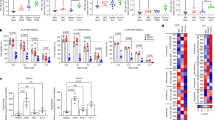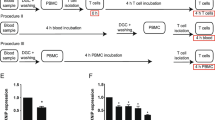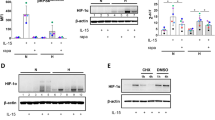Abstract
The investigative anti-tumour agent 5,6-dimethylxanthenonone-4-acetic acid (DMXAA, NSC 640488), developed in this laboratory as an improved analogue of flavone acetic acid (FAA, NSC 347512), is currently in clinical trial. The ability of DMXAA to up-regulate tumour necrosis factor (TNF) mRNA and protein synthesis in cultured human peripheral blood leucocytes (HPBLs) has been investigated and compared with that of flavone acetic acid (FAA) and of bacterial lipopolysaccharide (LPS). Human peripheral blood leucocytes were isolated from buffy coats obtained from a blood transfusion centre and also from blood samples from laboratory volunteers. At a concentration of 400 microg ml(-1) and an incubation time of 2 h, DMXAA up-regulated mRNA synthesis in six of eight individuals tested, as measured by Northern blotting. The degree of up-regulation varied in different individuals from one to nine times that of control levels. In contrast, FAA caused no induction above that of control levels and in some cases suppressed expression relative to controls, extending previous data that DMXAA but not FAA up-regulates TNF mRNA in the human HL-60 tumour cell line. At the same concentration but with longer incubation times (6-12 h), DMXAA induced increases in TNF protein in 11 of 15 samples of HPBLs from buffy coats and also in 11 of 15 samples of HPBLs from volunteers, as measured by cytotoxicity assays with L929 cells. FAA caused no increase in TNF protein, while LPS induced TNF to approximately 20-fold higher levels than did DMXAA. Considerable heterogeneity of response was observed with both sources of HPBLs, and there was little or no correlation between the extent of TNF induction by DMXAA and LPS in individual samples. In vitro analysis of the response of human peripheral blood leucocytes to DMXAA may be a useful test in clinical trials of agents such as DMXAA.
This is a preview of subscription content, access via your institution
Access options
Subscribe to this journal
Receive 24 print issues and online access
$259.00 per year
only $10.79 per issue
Buy this article
- Purchase on Springer Link
- Instant access to full article PDF
Prices may be subject to local taxes which are calculated during checkout
Similar content being viewed by others
Author information
Authors and Affiliations
Rights and permissions
About this article
Cite this article
Philpott, M., Joseph, W., Crosier, K. et al. Production of tumour necrosis factor-α by cultured human peripheral blood leucocytes in response to the anti-tumour agent 5,6-dimethylxanthenone-4-acetic acid (NSC 640488). Br J Cancer 76, 1586–1591 (1997). https://doi.org/10.1038/bjc.1997.601
Issue Date:
DOI: https://doi.org/10.1038/bjc.1997.601
This article is cited by
-
Vascular targeting agents
Current Oncology Reports (2004)
-
Clinical aspects of a phase I trial of 5,6-dimethylxanthenone-4-acetic acid (DMXAA), a novel antivascular agent
British Journal of Cancer (2003)
-
Thalidomide increases both intra-tumoural tumour necrosis factor-α production and anti-tumour activity in response to 5,6-dimethylxanthenone-4-acetic acid
British Journal of Cancer (1999)



